Abstract
In guinea pigs fed ad libitum, controlled intraperitoneal infusion of bacteria by an implanted 7-day osmotic pump resulted in peritonitis or abscess formation with a 50% survival 14-18 days after pump implantation. Administration of 125 kcal/kg/day of a diet found to be optimal for burned guinea pigs by continuous pump controlled feedings via a previously placed gastrostomy was well-tolerated, with a 62.5% mortality by Day 17. Administration of only 100 kcal/kg/day caused weight loss of approximately 17% after 16 days, but fewer animals died (42.8%, p = NS). Feeding either 150 kcal/kg/day or 175 kcal/kg/day caused death in all 25 animals (p less than 0.001) and their survival time was slightly shortened (p = NS) when compared with animals receiving 100 or 125 kcal/kg/day. This is the first animal model of peritonitis that permits incisive dissection of the relative influences of dietary composition on outcome, because survival can be extended to 2 weeks or more in the presence of continuing sepsis.
Full text
PDF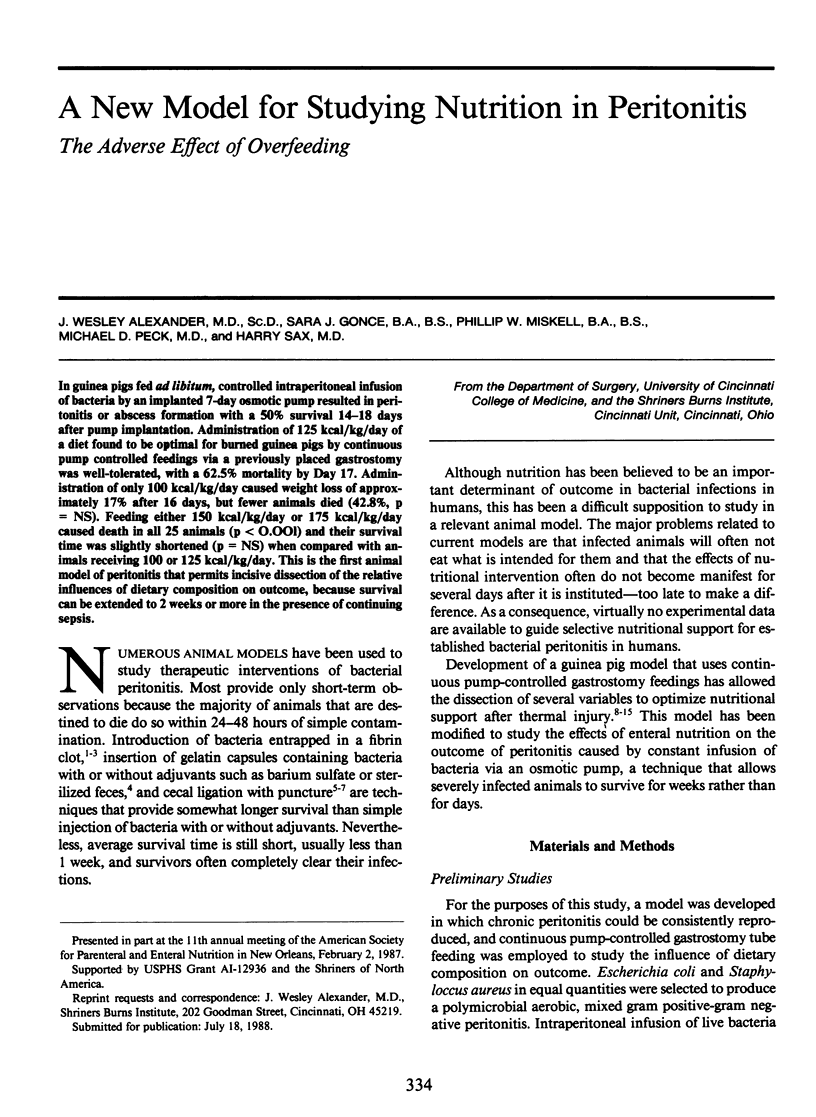
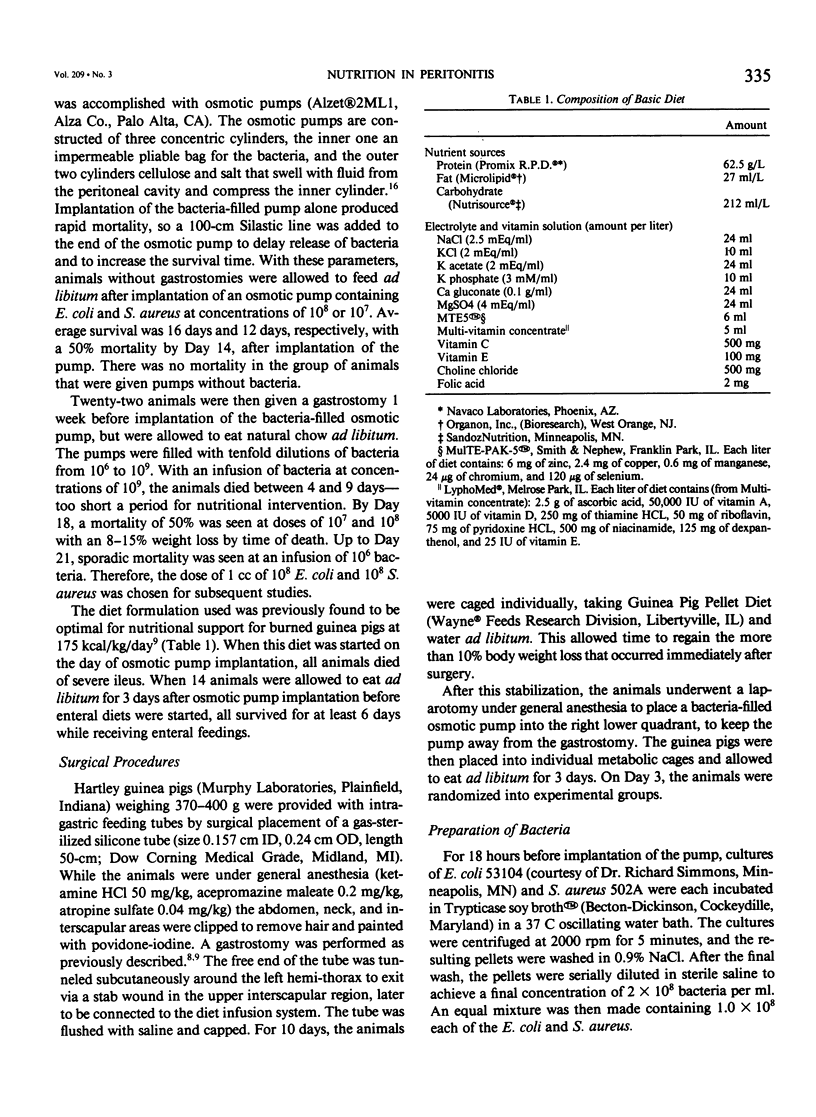
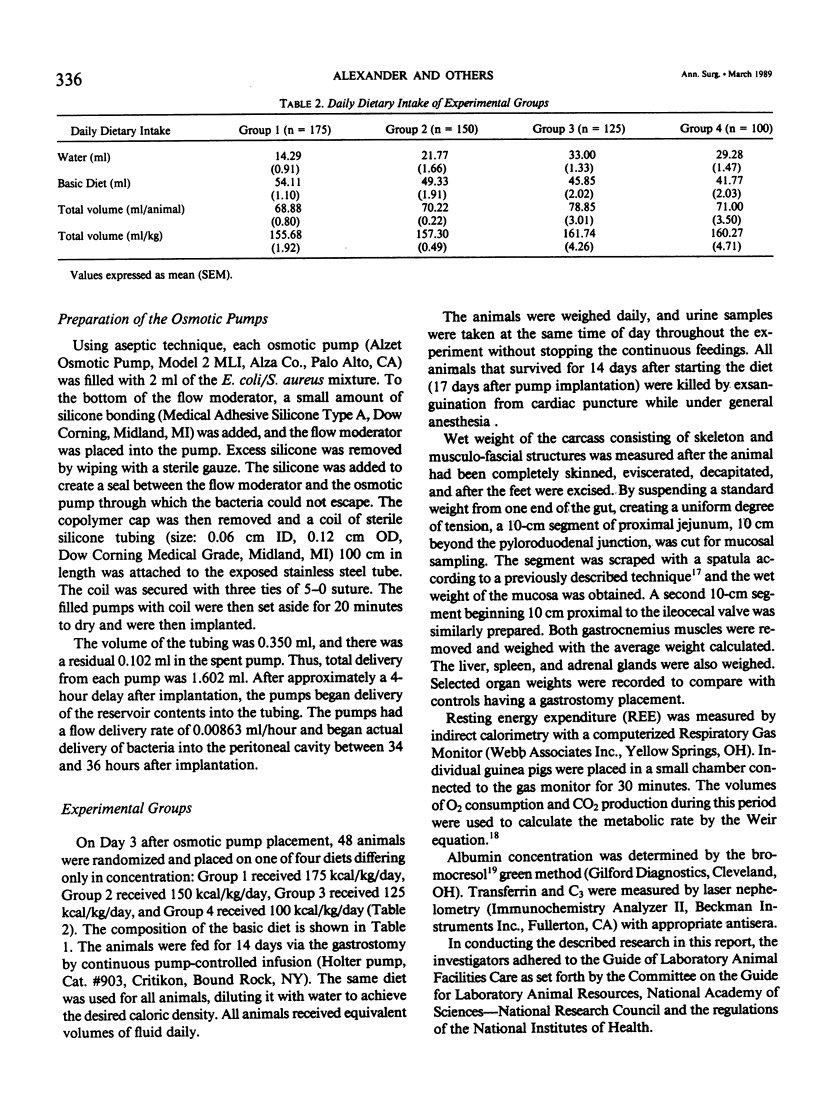
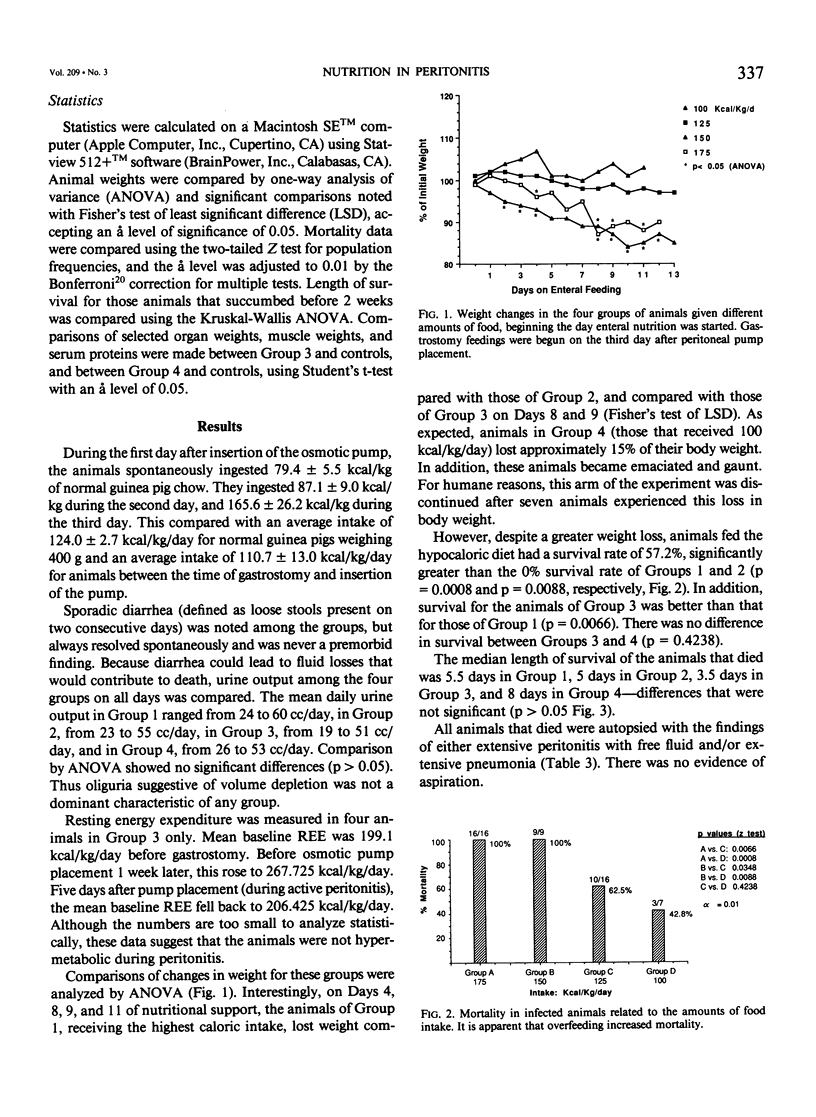
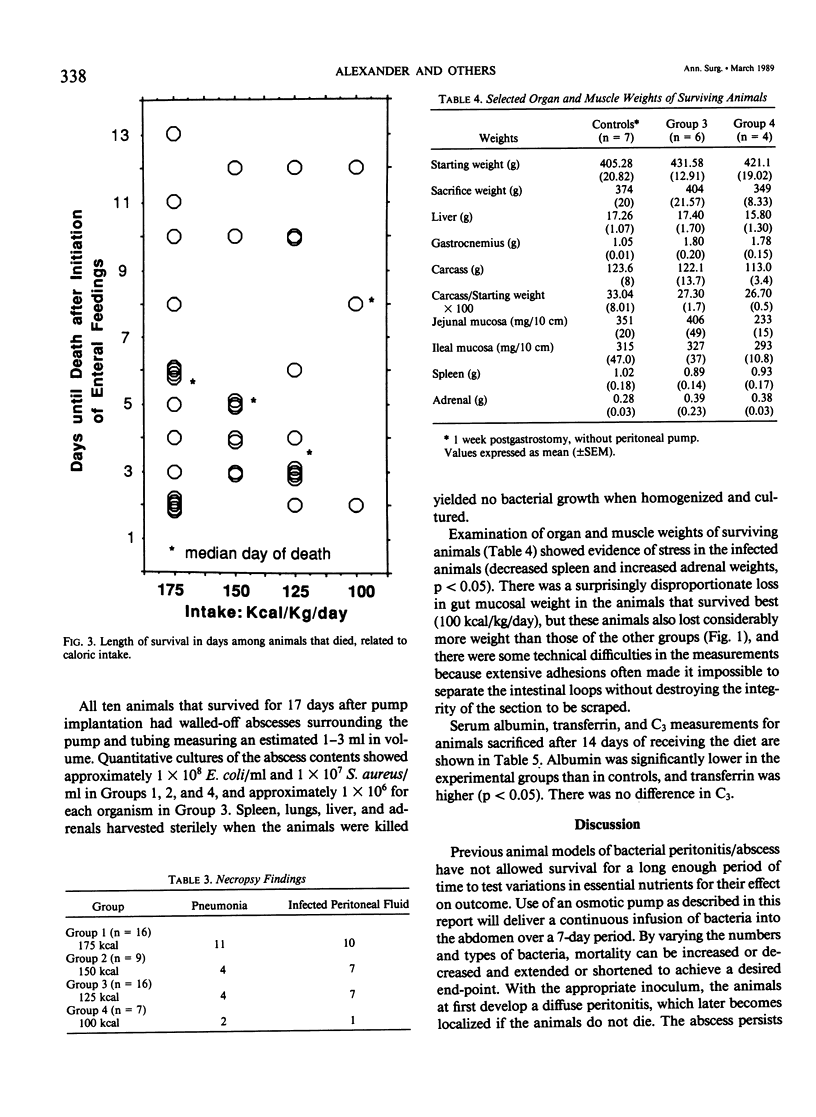
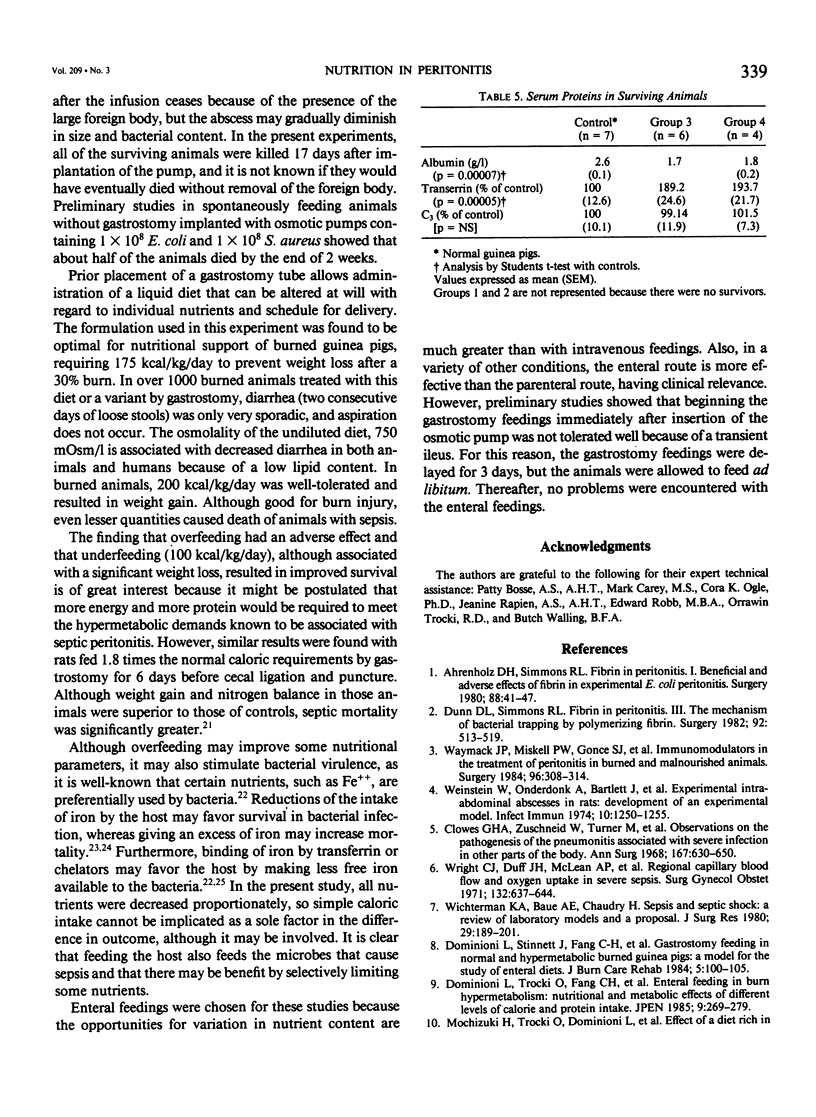
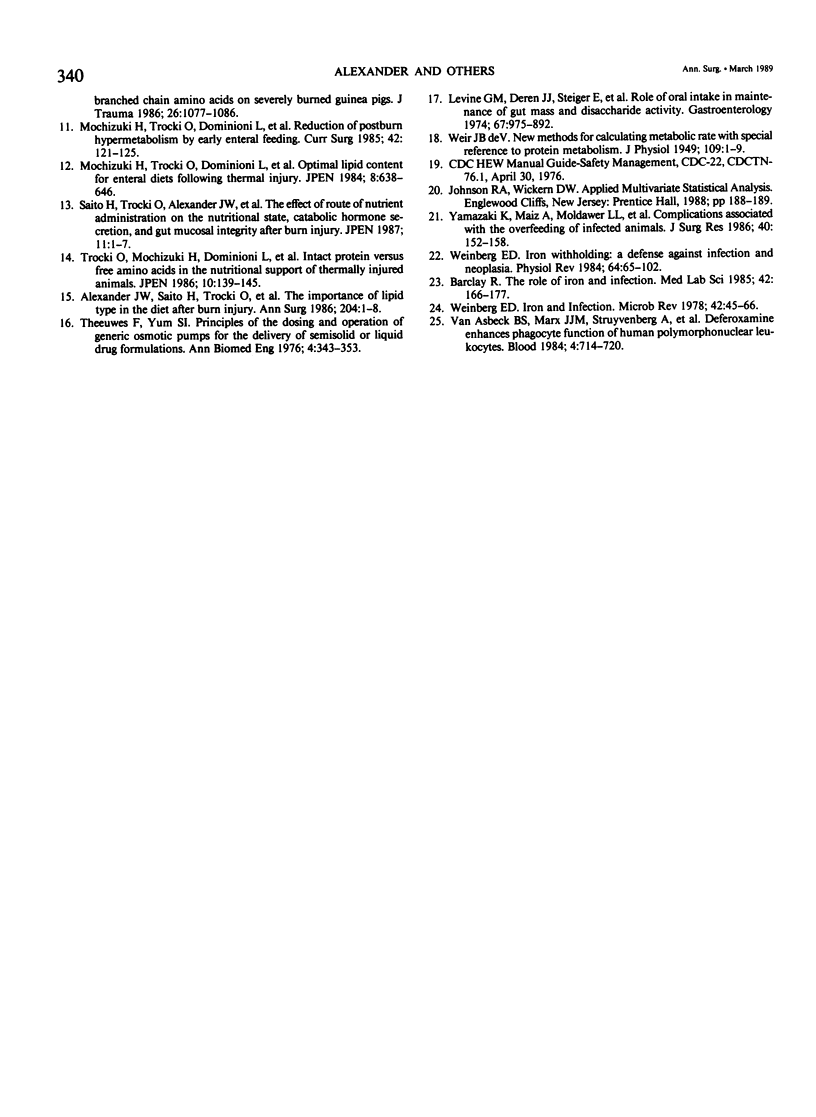
Selected References
These references are in PubMed. This may not be the complete list of references from this article.
- Ahrenholz D. H., Simmons R. L. Fibrin in peritonitis. I. Beneficial and adverse effects of fibrin in experimental E. coli peritonitis. Surgery. 1980 Jul;88(1):41–47. [PubMed] [Google Scholar]
- Alexander J. W., Saito H., Trocki O., Ogle C. K. The importance of lipid type in the diet after burn injury. Ann Surg. 1986 Jul;204(1):1–8. doi: 10.1097/00000658-198607000-00001. [DOI] [PMC free article] [PubMed] [Google Scholar]
- Barclay R. The role of iron in infection. Med Lab Sci. 1985 Apr;42(2):166–177. [PubMed] [Google Scholar]
- Clowes G. H., Jr, Zuschneid W., Turner M., Blackburn G., Rubin J., Toala P., Green G. Observations on the pathogenesis of the pneumonitis associated with severe infections in other parts of the body. Ann Surg. 1968 May;167(5):630–650. doi: 10.1097/00000658-196805000-00003. [DOI] [PMC free article] [PubMed] [Google Scholar]
- Dominioni L., Trocki O., Fang C. H., Mochizuki H., Ray M. B., Ogle C. K., Alexander J. W. Enteral feeding in burn hypermetabolism: nutritional and metabolic effects of different levels of calorie and protein intake. JPEN J Parenter Enteral Nutr. 1985 May-Jun;9(3):269–279. doi: 10.1177/0148607185009003269. [DOI] [PubMed] [Google Scholar]
- Dunn D. L., Simmons R. L. Fibrin in peritonitis. III. The mechanism of bacterial trapping by polymerizing fibrin. Surgery. 1982 Sep;92(3):513–519. [PubMed] [Google Scholar]
- Levine G. M., Deren J. J., Steiger E., Zinno R. Role of oral intake in maintenance of gut mass and disaccharide activity. Gastroenterology. 1974 Nov;67(5):975–982. [PubMed] [Google Scholar]
- Mochizuki H., Trocki O., Dominioni L., Alexander J. W. Effect of a diet rich in branched chain amino acids on severely burned guinea pigs. J Trauma. 1986 Dec;26(12):1077–1085. doi: 10.1097/00005373-198612000-00003. [DOI] [PubMed] [Google Scholar]
- Mochizuki H., Trocki O., Dominioni L., Alexander J. W. Reduction of postburn hypermetabolism by early enteral feeding. Curr Surg. 1985 Mar-Apr;42(2):121–125. [PubMed] [Google Scholar]
- Mochizuki H., Trocki O., Dominioni L., Ray M. B., Alexander J. W. Optimal lipid content for enteral diets following thermal injury. JPEN J Parenter Enteral Nutr. 1984 Nov-Dec;8(6):638–646. doi: 10.1177/0148607184008006638. [DOI] [PubMed] [Google Scholar]
- Saito H., Trocki O., Alexander J. W., Kopcha R., Heyd T., Joffe S. N. The effect of route of nutrient administration on the nutritional state, catabolic hormone secretion, and gut mucosal integrity after burn injury. JPEN J Parenter Enteral Nutr. 1987 Jan-Feb;11(1):1–7. doi: 10.1177/014860718701100101. [DOI] [PubMed] [Google Scholar]
- Theeuwes F., Yum S. I. Principles of the design and operation of generic osmotic pumps for the delivery of semisolid or liquid drug formulations. Ann Biomed Eng. 1976 Dec;4(4):343–353. doi: 10.1007/BF02584524. [DOI] [PubMed] [Google Scholar]
- Trocki O., Mochizuki H., Dominioni L., Alexander J. W. Intact protein versus free amino acids in the nutritional support of thermally injured animals. JPEN J Parenter Enteral Nutr. 1986 Mar-Apr;10(2):139–145. doi: 10.1177/0148607186010002139. [DOI] [PubMed] [Google Scholar]
- Waymack J. P., Miskell P., Gonce S. J., Alexander J. W. Immunomodulators in the treatment of peritonitis in burned and malnourished animals. Surgery. 1984 Aug;96(2):308–314. [PubMed] [Google Scholar]
- Weinberg E. D. Iron and infection. Microbiol Rev. 1978 Mar;42(1):45–66. doi: 10.1128/mr.42.1.45-66.1978. [DOI] [PMC free article] [PubMed] [Google Scholar]
- Weinberg E. D. Iron withholding: a defense against infection and neoplasia. Physiol Rev. 1984 Jan;64(1):65–102. doi: 10.1152/physrev.1984.64.1.65. [DOI] [PubMed] [Google Scholar]
- Weinstein W. M., Onderdonk A. B., Bartlett J. G., Gorbach S. L. Experimental intra-abdominal abscesses in rats: development of an experimental model. Infect Immun. 1974 Dec;10(6):1250–1255. doi: 10.1128/iai.10.6.1250-1255.1974. [DOI] [PMC free article] [PubMed] [Google Scholar]
- Wichterman K. A., Baue A. E., Chaudry I. H. Sepsis and septic shock--a review of laboratory models and a proposal. J Surg Res. 1980 Aug;29(2):189–201. doi: 10.1016/0022-4804(80)90037-2. [DOI] [PubMed] [Google Scholar]
- Wright C. J., Duff J. H., McLean A. P., MacLean L. D. Regional capillary blood flow and oxygen uptake in severe sepsis. Surg Gynecol Obstet. 1971 Apr;132(4):637–644. [PubMed] [Google Scholar]
- Yamazaki K., Maiz A., Moldawer L. L., Bistrian B. R., Blackburn G. L. Complications associated with the overfeeding of infected animals. J Surg Res. 1986 Feb;40(2):152–158. doi: 10.1016/0022-4804(86)90117-4. [DOI] [PubMed] [Google Scholar]
- van Asbeck B. S., Marx J. J., Struyvenberg A., van Kats J. H., Verhoef J. Deferoxamine enhances phagocytic function of human polymorphonuclear leukocytes. Blood. 1984 Mar;63(3):714–720. [PubMed] [Google Scholar]


